Why it's time to acknowledge Germaine Greer, journalist
- Written by Rachel Buchanan, Curator, Germaine Greer Archive, University of Melbourne Archives, University of Melbourne
The pages of Germaine Greer’s University of Warwick diary for 1971 are mostly blank; she was too busy to fill them out. After April 20, 1971, publication day for The Female Eunuch in the United States, Greer plotted her life in single words or urgent phrases. Hamburg. Leave for Sardinia. Quarrel with Ken. Arr. Paris. Esquire Round Table Luncheon. Canada. WET DREAM. Hanoi?
April 30, 1971, the night Greer appeared on stage at the New York Town Hall with Norman Mailer, Diana Trilling, Jackie Ceballos and Jill Johnson, is blank. So are the pages around it. The Dialogue on Women’s Liberation, as the 1971 event was called, is the subject of a documentary film (Town Bloody Hall, 1979) and that film has been turned into a piece of theatre by the New York-based Wooster Group. The Town Hall Affair is on now at the 2018 Sydney Festival and Greer is giving a public lecture tonight at the Sydney Opera House.
The town hall debate just keeps getting bigger but for Greer back then, it was a minor extravaganza. A more significant thing happened on June 1, 1971. “Column begins,” Greer has written in the diary, one of thousands of records in the 500 boxes that comprise the Germaine Greer Archive at University of Melbourne Archives.
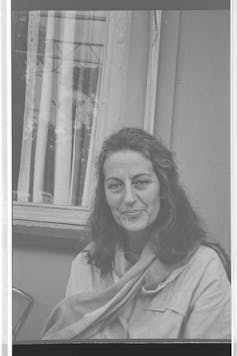 Portrait of Germaine Greer, Ethiopia, 1985.
Photographer unknown. Photograph is image 21 of 37 contained on a roll of negatives. University of Melbourne Archives, Germaine Greer Archive, 2014.0044.00258, Ethiopia (a) negatives, roll 11 of 16.
Portrait of Germaine Greer, Ethiopia, 1985.
Photographer unknown. Photograph is image 21 of 37 contained on a roll of negatives. University of Melbourne Archives, Germaine Greer Archive, 2014.0044.00258, Ethiopia (a) negatives, roll 11 of 16.
This entry is the start of one of the most important but least recognised aspects of Greer’s professional life – her international career as a journalist. The column Greer is referring to is the bi-weekly one she wrote for The Sunday Times, at the invitation of editor Harold Evans.
Greer was a veteran of the student and underground presses but the Times column was her first paid gig. Her journalism career had begun with the publication of an essay on rationalism in Farrago, the University of Melbourne’s student newspaper, in 1959. (Greer’s clipping of this piece and a 1971 press pass are on display at Melbourne’s City Gallery, for the Ink in the Blood exhibition.)
For the next 12 years, Greer wrote theatre reviews for student papers in Sydney and Cambridge and satirical essays for London-based OZ magazine and Suck, “the first European sexpaper”.
Greer’s inaugural Look! column (on vaginal deodorants) ran on July 25, 1971. Diary notes say she went to Hamburg to watch a live sex show, then to Vietnam, where she researched a piece on Vietnamese “bar girls” who had babies to American soldiers.
Her research notes, including contacts for fixers (locals employed by foreign correspondents) and typescripts are in the Print Journalism series, a collection of 1,268 folders, housed in 24 boxes, that document Greer’s journalism from 1959 until 2010.
‘Laborious investigation’
The photograph attached to her press pass, issued in November 1971 in Hanoi, depicts a woman who is tough, tired, no bullshit. The glamorous, naughty scholar who dressed up in an op shop slip and fox fur and flirted with Norman Mailer in front of an audience of “diamond-studded radical chic New Yorkers” only seven months earlier is gone. This face belongs to a reporter in a war zone. The quote about radical chic comes from Greer’s cover story for Esquire in September 1971.
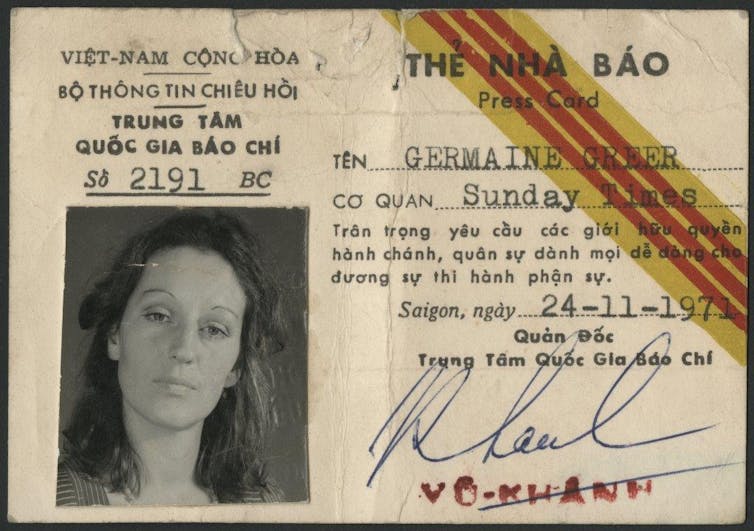 Press pass issued to Germaine Greer, November 24, 1971, Hanoi. Greer went to Vietnam to research a column for The Sunday Times.
University of Melbourne Archives, Germaine Greer Archive, 2014.0046.01280, [Vietnam Press Pass].
Press pass issued to Germaine Greer, November 24, 1971, Hanoi. Greer went to Vietnam to research a column for The Sunday Times.
University of Melbourne Archives, Germaine Greer Archive, 2014.0046.01280, [Vietnam Press Pass].
After Vietnam, Greer went to Bangladesh and interviewed women who had been raped by Pakistani soldiers during the 1971 war of independence.
Greer has also been a columnist for The Spectator, The Oldie, The Independent, The Guardian and The Daily Telegraph, among others, and her features and essays have been published in the world’s best newspapers and magazines. The most significant collection of journalism records in the archive document Greer’s work as a foreign correspondent in Ethiopia. Greer went in 1984 (for the Daily Mail), in April 1985 (for The Observer) and in September (as a presenter for Diverse Reports – Ethiopia, a TV documentary that screened on 23 October, 1985 on Channel 4).
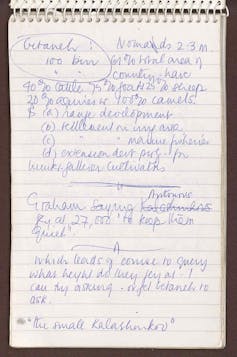 Detail from Germaine Greer’s reporter’s notebook, Ethiopia, April 1985.
University of Melbourne Archives, Germaine Greer Archive, 2014.0045.00134, Ethiopia reporter’s notebook A. Copyright: University of Melbourne.
Detail from Germaine Greer’s reporter’s notebook, Ethiopia, April 1985.
University of Melbourne Archives, Germaine Greer Archive, 2014.0045.00134, Ethiopia reporter’s notebook A. Copyright: University of Melbourne.
After the first trip, Greer was determined to go back and report on what Ethiopians themselves were doing to ease the catastrophe of famine. She pitched her idea to The Observer.
“The kind of laborious investigation I have in mind will take time; the results will not be the sort of sensational expose which is what foreign correspondents usually think it is their job to get, but they will be interesting and moving just the same – I know this from having been there before,” Greer told Observer editor Donald Trelford in a letter of February 18, 1985.
The Ethiopian government’s Refugee Resettlement Commission was moving people from famine zones in the north to more fertile ones in the south and west and Greer was one of the few foreign journalists to travel with resettlement convoys either on the buses or in a Toyota LandCruiser she hired. At one stage, she drove 700 kilometres over unmade roads to Asosa, a resettlement city on Ethiopia’s eastern edge. A big road map (92cm x 90cm) is hand-annotated by Greer in pen and pink felt tip and marked with coffee rings and fragments of text in Ethiopian.
For a month, Greer used her Olympic quick flash camera to capture a different side of the famine to the one being presented by the international media and by aid organisations. She circled a starving nation and took photos of people surrounded by food; women selling mangoes, men milling flour or tending beehives or planting seedlings in a greenhouse.
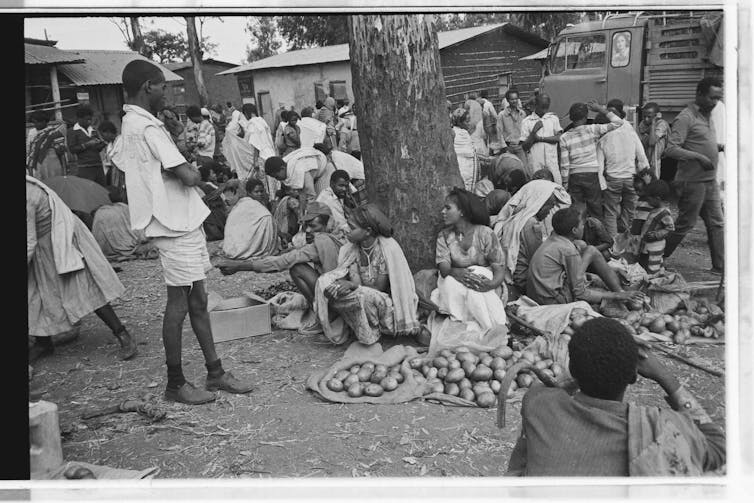 Women selling mangoes at a market in Gambella, a city south of Asosa on the eastern border of Ethiopia and Sudan, April 1985.
Photo: Germaine Greer. Photograph is image 18 of 24 on roll of negatives. University of Melbourne Archives, Germaine Greer Archive, 2014.0044.00255, Ethiopia (a) negatives, roll 8 of 16. Copyright: University of Melbourne.
Women selling mangoes at a market in Gambella, a city south of Asosa on the eastern border of Ethiopia and Sudan, April 1985.
Photo: Germaine Greer. Photograph is image 18 of 24 on roll of negatives. University of Melbourne Archives, Germaine Greer Archive, 2014.0044.00255, Ethiopia (a) negatives, roll 8 of 16. Copyright: University of Melbourne.
By May 14, Greer’s agent Gillon Aitken, sent Trelford Greer’s copy (two pieces, each more than 5,000 words) and 36 black and white prints, selected from 16 proof sheets. “I am not going to make a judgment on the pictures beyond saying that, from my amateur eye, they seem truthful and good,” Aitken wrote. “Regarding the text, I think this is Germaine at her best.”
The Observer decided not to run the articles. Greer said they did not want to be seen to endorse her (pro-government) views. “No one has suggested that I did not see what I said I saw,” Greer wrote. She had “ocular proof” in the form of hundreds of pictures on contact sheets “because I did as you suggested and bought an automatic camera and embarrassed myself hideously by using it”.
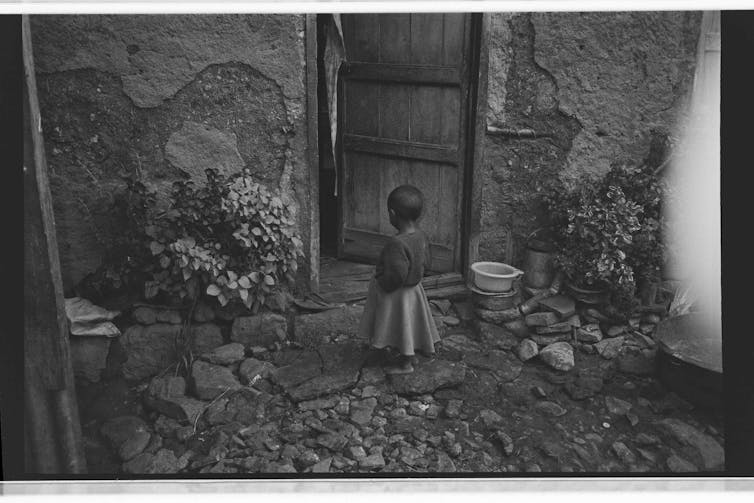 Child in a doorway, Ethiopia, 1985.
Photo: Germaine Greer. Photograph is image 32 of 37 contained on a roll of negatives. University of Melbourne Archives, Germaine Greer Archive, 2014.0044.00258, Ethiopia (a) negatives, roll 11 of 16.Copyright: University of Melbourne Archives.
Child in a doorway, Ethiopia, 1985.
Photo: Germaine Greer. Photograph is image 32 of 37 contained on a roll of negatives. University of Melbourne Archives, Germaine Greer Archive, 2014.0044.00258, Ethiopia (a) negatives, roll 11 of 16.Copyright: University of Melbourne Archives.
Greer’s agent insisted the paper pay Greer’s expenses and a kill fee of £5000. On October 7, the paper issued her a cheque for £9609.90. Greer photocopied the cheque and inserted it into a folder in the Print Journalism series that she labelled “The True Story of Ethiopian resettlement, The New Worker. 10.i.86”. The New Worker is the weekly newspaper of the New Communist Party of Britain. It published seven of Greer’s photos and a long interview with her.
‘A fantastic eye for a picture’
Much of the material relating to Greer’s journalism in Ethiopia, including typescripts, ephemera, reporter’s notebooks, letters and the road map has been digitised and published on the University of Melbourne Archives catalogue. In all, there are 51 records relating to Greer’s reportage in Ethiopia and to her ongoing attempts to understand what this experience meant for her.
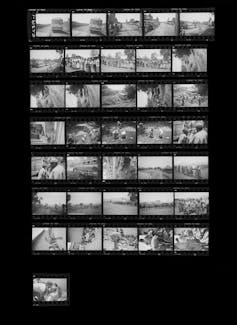 Proof sheet, 1 of 15, 24cm x 30.5cm black and white pictures taken by Germaine Greer while she was on assignment for The Observer.
University of Melbourne Archives, Germaine Greer Archive, 2014.0044.00265, Ethiopia (b) proof sheets 1 of 15, 1985. Copyright: University of Melbourne.
Proof sheet, 1 of 15, 24cm x 30.5cm black and white pictures taken by Germaine Greer while she was on assignment for The Observer.
University of Melbourne Archives, Germaine Greer Archive, 2014.0044.00265, Ethiopia (b) proof sheets 1 of 15, 1985. Copyright: University of Melbourne.
Greer’s pictures are extraordinary. We digitised 15 rolls of negatives and the related proof sheets. Opaque analogue records – 561 pictures hidden on strips of 35mm black and white Kodak film – have been transformed into a series of powerful visual essays.
I have charted the journey described in Greer’s piece, Resettlement, Ethiopia 1985 (published in 1986 in an anthology, The Madwoman’s Underclothes) with audio diaries, her road map and the photographs.
In time, I plan to work with Ethiopian communities to try and identify people in the photos. She appeared to have a good rapport with the people she met. On several rolls of film, Greer’s face pops up - she has handed over her camera; a nice gesture of reciprocity.
Greer was “embarrassed” about her photos. A snippet of audio from Ethiopia Resettlement captures her anxiety. “I’m not sure I get things in focus,” she tells her cassette recorder. “I mean in frame I should probably say.”
I’m not the only one who disagrees.
Between 1984 and 1987, Alex Graham was the program editor for Diverse Reports, a 30-minute analytical news program made for Channel 4. He now chairs the Scott Trust, owner of The Guardian and The Observer.
“I’ve only just now had time to properly look through some of the photographs,” Graham wrote to me in November. “They really are remarkable. She clearly has a fantastic eye for a picture!”
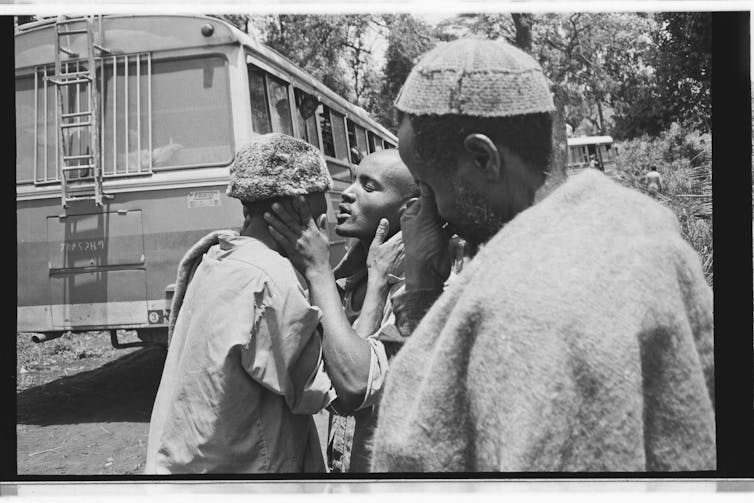 Joy and sorrow on arrival at Kone settlement site – two brothers are reunited, but another man has received bad news from home.
Photo and caption: Germaine Greer. University of Melbourne Archives, Germaine Greer Archive, 2014.0044.00248, Ethiopia (a) negatives roll 1 of 16. Copyright: University of Melbourne. Photo first published New Worker, 1986.
Joy and sorrow on arrival at Kone settlement site – two brothers are reunited, but another man has received bad news from home.
Photo and caption: Germaine Greer. University of Melbourne Archives, Germaine Greer Archive, 2014.0044.00248, Ethiopia (a) negatives roll 1 of 16. Copyright: University of Melbourne. Photo first published New Worker, 1986.
Graham was not aware of Greer’s photography; he had worked with her on the television program. As program editor, his aim was to find provocative and iconoclastic ideas that would otherwise struggle to find a place on mainstream TV. “That was the origin of Germaine’s film,” he said.
The film argued that Ethiopia had become the “media famine” just as Vietnam became the “media war” and sought to counter allegations that the Refugee Resettlement Commission was forcibly removing people. It also wanted to show that Ethiopians were able to help themselves and not utterly dependent on Western acts of charity.
“We [Diverse Reports] made it in the aftermath of Band Aid and the beatification of Bob Geldof and its message was one which many people did not want to hear. But I felt there were important criticisms [in it] of Live Aid and the work of NGOs in Ethiopia which needed to be heard,” said Graham.
Graham’s hand-annotated outline for Diverse Reports - Ethiopia is 32 years old but the words still feel urgent and new. “A year ago, Ethiopia became a household word. The agony and humiliation of slow death by famine became public property,” the script reads.
“Ethiopians had to recognise that they had become beggars on a global scale. A new kind of sensationalism was born as photographers vied with each other to catch the most appalling, and hence the most moving, images. The typical famine victim was a child on the point of death, the typical Ethiopian adult was helpless, apathetic totally dependent on kindness from strangers.”
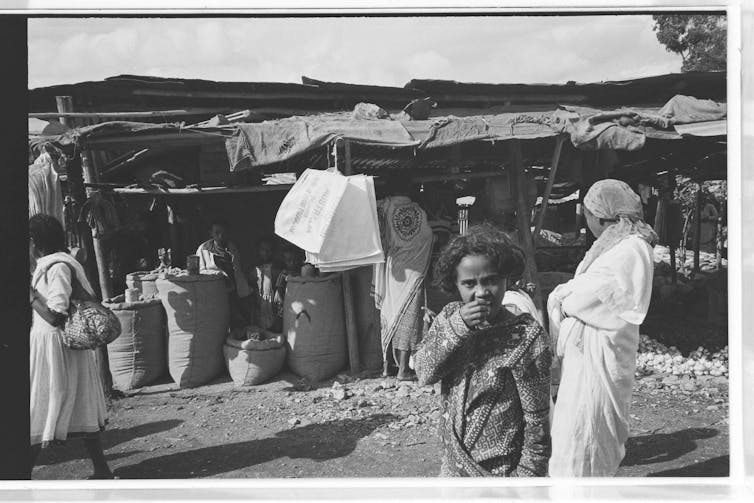 Donation of Australia Through World Food Program, Ethiopia 1985.
Photo: Germaine Greer. Photograph is image 3 of 37 contained on a roll of negatives. University of Melbourne Archives, Germaine Greer Archive, 2014.0044.00258, Ethiopia (a) negatives, roll 11 of 16. Copyright: University of Melbourne.
Donation of Australia Through World Food Program, Ethiopia 1985.
Photo: Germaine Greer. Photograph is image 3 of 37 contained on a roll of negatives. University of Melbourne Archives, Germaine Greer Archive, 2014.0044.00258, Ethiopia (a) negatives, roll 11 of 16. Copyright: University of Melbourne.
Greer’s photographs let us marvel at these strong people doing what they can to survive a disaster. The pictures invite reflection on the famine now engulfing East Africa and how little we are seeing of that.
As part of the project, I also tracked down veteran Canadian TV journalist Brian Stewart, who wrote a fan letter to Greer after watching her Ethiopia documentary. Stewart was the first foreign correspondent into Ethiopia and his initial report spurred many famine aid projects, including Geldof’s Live Aid rock concerts in July 1985.
Stewart granted me permission to publish his letter to Greer on the proviso that I explain his views have changed. Although he admires Greer as “a superb and brave correspondent and commentator” he now considers the Resettlement Program that both he and Greer championed to be an “act of tragic repression”.
Greer did some of her best journalism in 1985. She started off in Cuba and interviewed revolutionary Vilma Espin. A recording of this encounter is held in the archive. Another recording Greer made on that trip, at the fourth congress of the Federation of Cuban Women, includes questions from a male voice – Espin’s brother-in-law, Fidel Castro. Between the April and September trips to Ethiopia, Greer bought her country property at The Mills, Essex. In October, Greer interviewed Italian philosopher Primo Levi in Turin and the resulting piece was published in The Literary Review. The astonishing conversation was conducted in Italian, a language she spoke fluently.
Greer’s legacy needs to be liberated from The Female Eunuch.
To see Greer’s pictures, type Ethiopia in to search this digitised records box. You can read letters from Stewart, Graham, Greer and researcher Roy Ackerman by typing Diverse Reports into the same spot. A scholarly essay on Greer’s journalism will be published in Archives and Manuscripts in March.
Authors: Rachel Buchanan, Curator, Germaine Greer Archive, University of Melbourne Archives, University of Melbourne
Read more http://theconversation.com/why-its-time-to-acknowledge-germaine-greer-journalist-88958



